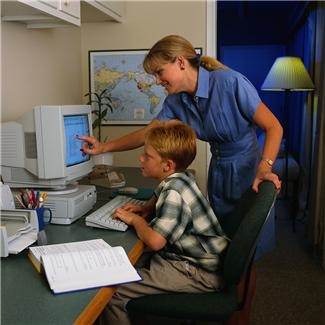by Neva Fenno, M.S.Ed., MLIS
Last time, I talked about blended learning environments for special education classrooms. With this learning model, we might want to talk about testing for our special needs children; are there new technologies that help teachers work with Common Core State Standards (CCSS) at testing time?
I remember in the late 90’s when we were starting to embrace learning standards and develop new high-stakes tests. We heard a loud shriek throughout the land from teachers and parents who were sure their special needs children were going to be relegated to academic Siberia and required to take the same tests as “regular” children. It was a justifiable shriek; it seemed no one had really thought about this thorny issue, at least not very thoroughly.
We’ve calmed down since then, and now realize that requiring special needs students to take and pass high-stakes tests is just the equivalent of raising standards and expectations for all students, and providing the least restrictive environment—which is always a good thing. We’ve developed accommodations for children who need extra support at test time.
According to the law1
Testing accommodations are neither intended nor permitted to:
- alter the construct of the test being measured or invalidate the results
- provide an unfair advantage for students with disabilities over students taking tests under standardized conditions
- substitute for knowledge or abilities that the student has not attained
The testing accommodations most frequently required by students as indicated in their IEP’s are:
- flexibility in scheduling/timing
- flexibility in the setting used for the administration of assessments
- changes in the method of presentation
- changes in the method of response
The key here is “in the IEP.” We have found ways to include many accommodations for special needs children in their IEP’s. We have struggled to find methods of assistance that don’t alter the tests or invalidate the results.
The NCEO (National Center for Educational Outcomes) provides a helpful bibliography of research-tested accommodations for testing. They also provide a nice description of differences among accommodations and discussions on test validity and reliability. There is considerable variability among states for the development of accommodations. Over time, states have developed alternate assessments that align with alternate state standards. We have also struggled with providing support for ELL students who have special needs.
Where does technology step in to help us out with all these delicate balancing acts? A practical discussion of different ways classrooms can manage accommodations can be found at http://drscavanaugh.org/assistive/technology_accommodations.htm.
Teachervision has been one of my favorite sites over the years. They apply teacher speak to most of the ideas they present, and this article on assistive technology for students with mild disabilities is an example of that. Adaptive technologies may or may not be carried over into the testing environment. Remember the IEP? It may be allowed in the IEP, but here are some resources to help you sort this out.
Partnership for Assessment of Readiness for College and Career (PARCC) provides some guidance on using adaptive technologies for testing. PARCC is a group of states working together to develop a set of assessments that measure whether students are on track to be successful in college and their careers.
But, I digress. There are as many organizations, companies and others who are interested in creating and providing testing materials and guidance as there are stars in the sky, and for obvious reasons. There is a great deal of money to be made. Rather than insert my opinions about this, I’ll provide you with some (hopefully) unbiased resources to help districts with assistive technology make decisions as they relate to testing.
University of Texas at Austin (study)
Smarter Balanced Assessment Consortium
One Parent’s Opinion (NY Times)
Indiana University (Assistive Technology and Assessment Center)
Let me know how your district has evolved on the subject of testing and the use of assistive technologies.
1Text taken from: http://www.p12.nysed.gov/specialed/publications/policy/testaccess/guidance.htm, New York State Education Department.
Grant Name: Teacher Art Grants
Funded By: P. Buckley Moss Foundation for Children’s Education
Description: The P. Buckley Moss Foundation for Children’s Education aids and supports teachers who wish to establish an effective learning tool using the arts in teaching children who learn differently. They look to support new or evolving programs that integrate the arts into educational programming.
Program Areas: Arts, Special Education
Eligibility: Public School, Private School
Proposal Deadline: 9/30/2015
Average Amount: $250.00 – $1,000.00
Address: 152 P. Buckley Moss Dr., Waynesboro, VA 22980
Telephone: 540-932-1728
Website: P. Buckley Moss Foundation for Children’s Education
Availability: All States







